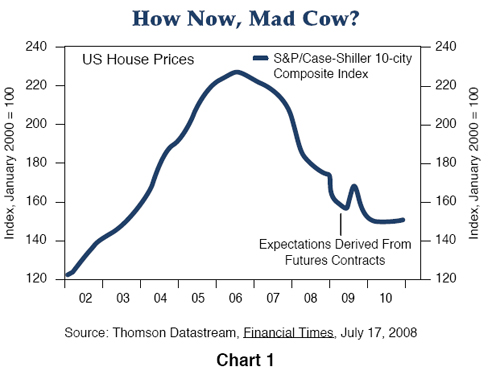News Home
Home - Index - News - Krisen 1992 - EMU - Economics - Cataclysm - Wall Street Bubbles - US Dollar - Houseprices
"the prospect for the economy isn’t V-shaped, it’s L-ish"
The prospect for the economy isn’t V-shaped, it’s L-ish
When will it all end?
The answer is, probably not until 2010 or later. Barack Obama, take notice.
PAUL KRUGMAN, NYT July 18, 2008
Real home prices, that is, prices adjusted for inflation in the rest of the economy, went up more than 70 percent from 2000 to 2006.
Since then they’ve come way down — but they’re still more than 30 percent above the 2000 level.
The 1990 recession officially ended in March 1991, but unemployment kept rising through much of 1992, allowing Bill Clinton to win the election on the basis of the economy, stupid.
The next recession officially began in March 2001 and ended in November, but unemployment kept rising until June 2003.
These prolonged recession-like episodes probably reflect the changing nature of the business cycle. Earlier recessions were more or less deliberately engineered by the Federal Reserve, which raised interest rates to control inflation.
Modern slumps, by contrast, have been hangovers from bouts of irrational exuberance — the savings and loan free-for-all of the 1980s, the technology bubble of the 1990s and now the housing bubble.
Ending those old-fashioned recessions was easy because all the Fed had to do was relent. Ending modern slumps is much more difficult because the economy needs to find something to replace the burst bubble.
Ur Marian Radetzkis bok "Klarspråk om arbetslöshet" (SNS Förlag, 1996) sid 34 ff och 81 ff, utdrag.
Ett enkel, mekaniskt, men ändå lärorikt sätt att spalta upp arbetslöshetproblemet bygger på följande samband:
Tillväxt i BNP minus ökning i produktivitet minus ökning i arbetsstyrkan = förändring i arbetslösheten.
Om BNP stiger med 3,2 procent och produktiviteten samtidigt ökar med 2,2 procent och antalet personer i arbetskraften ökar med 0,5 procent minskar arbetslösheten med 0,5 procentenheter.
"Sambandet är just ett samband. Så måste det helt enkelt vara."
